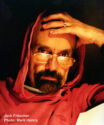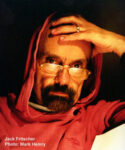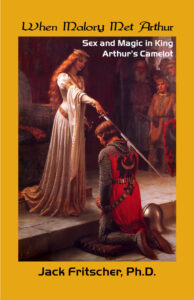Chapter also available as PDF
Preface
As literary artist, Sir Thomas Malory was nothing if not judiciously persevering. His virtue as litterateur far excelling his rapacious, now legendary, career provides fair enough credential of his own prime virtue of artistic stability. Confronted with reams of intransigent source material from books he had not always at hand, Malory successfully tread his way through the maze: he always kept his hand on some purposeful string that could lead him from adaptive beginning to creative end.
Malory’s Morte Darthur, if one line of many might be pursued through the text, appears a novel of religious education. “Ever since Malory’s time poets and critics have regarded the Morte Darthur as a means of moral and spiritual perfection.”[1] While latterly, particularly with Eugene Vinaver, disagreement on this point has arisen, the statement can nevertheless be textually substantiated that the Morte Darthur is an educative novel, in the widest sense religious.
In the educative novel, the protagonist learns a lesson. Sophocles’ Oedipus and Marlowe’s Faustus are educated heroes in this sense. Protagonists in Malory similarly arrive at a certain knowledge of individual salvation, thus extending the Horatian prodesse et delectare; for in the Morte the protagonists learn their lessons while the reader is himself instructed by and through his delight in their learning.
Vinaver in 1929 believed that Malory was concerned by no reunion of the knightly and monastic ideals of service, love, and sacrifice. What he advocated were the comfortable virtues of a righteous gentleman who “does after the good and leaves the evil,” but whose spiritual attainments are limited to social discipline and gentle manners.[2]
While Malory may indeed be writing a courtesy book as much the vogue as The Courtier or The Governour, he is writing more than the authors of the customary courtesy books. He writes a Christian gentleman’s guide. (For grace builds on nature.) He covers all the chivalric bases; yet does more. He is indirect social critic of his England, talking of “love nowadays”; yet he is more. William Caxton thought Malory didactic and moral,[3] yet begrudged him the vivid depictions of sin and bawdry, warning the readers of his edition to “Doo after the good and leve the evyl.” He recapitulates
…al is wryton for our doctryne, and for to beware that we falle not to vyce ne synne, but t’exersyse and follow vertu by whyche we may come…unto everlastyng blysse in heven….[4]
Caxton thus gives the book great moral worth, all the more creditable a judgment for being contemporary with Malory’s own religious-psychological orientation, peculiar to its time. The medieval mind held to essentially a group-institutional identity. In contradistinction, the modern mind has sought the identity of the individual existential. Malory, by peculiar happenstance, wrote within the precise band of historical transition. Thus Malory’s protagonists receive education, and it is the education of the individual to personal salvation both by and out of the institution in which he discovers himself.
Hardly more than pedestrian in particular stylistic metaphor patterns, Malory nevertheless is product enough of his medieval age to partake of its comprehensiveness. He sees not only the literal meaning of life but also the general symbolic metaphor that underlies all for the genuine medievalist. Thus Jean Misrahi says, “One cardinal principle of the symbolic interpreters of medieval romance is that we modern readers have lost the key to the symbolic intellectual background of the medieval mind, so that we detect no symbolic meanings where medieval audiences grasped them immediately….”[5] Thus Malory’s broadly metaphorical artistic sense (the form) couples with the “constant medieval sense of religion, of man in relation to God, to good, and to evil”[6] (the matter) to produce an organically functional work of moral edification and delightful reading.[7]
Vinaver seems overly simplistic in his literal reading of social discipline and gentle manners. Malory was no mere Dale Carnegie. The complicating fact is Vinaver is correct but goes not far enough. He minimizes the socio-moral tension involved between the gentlemanly seductions of fin amour and the hortative Christian respect for women ideally permeating Malory’s contemporary Christian society. The point is that a society functioning on a basically metaphorical level sees social discipline and gentle manners as etiquette, indeed, and more than etiquette.
Religion, therefore, cannot be reduced to mean the life of the cloister as opposed to the life of the world. Malory’s knights are
to go on being knights…, just as the soldiers who came to the Baptist were told to go on being soldiers. (Luke iii. 14) Malory in fact holds the same view as Langland and Gower and many other English medieval moralists. No man need leave the order to which he has been called.[8]
The literal life of the aristocracy will and must continue while on a deeper level this literal life is exemplum of a higher metaphorical truth negotiable in a society whose theology benevolently dominated the arts. Thus religion includes, complementary of its requirement for belief in a divine power, the ritual response of worship, the ethical response of socio-moral relationships, and oftentimes a well-defined philosophy. The interacting compatibility of these elements finds operational, but often paradoxical, expression in the Christian social counsel to be in the world but not of it. The “being in” is certainly literal; the “not being of it” implies a religious-moral transcendence of the literal which transcendence can best be expressed in art by metaphor.
In this way Malory, who at first seems a highly literal man, employs a highly pervasive religious metaphor. The medieval society was this-worldly; but behind this world, lay the other world and its eternal reward. Always unseen, this other world required and received confirmation of existence through artistic metaphor not only in literature, but in the sister arts. Malory created his Round Table society in an era that accepted “the historicity of original sin and the reality of the seven deadly sins.”[9] Though Alfred Lord Tennyson and Lytton Strachey may be excused for their Victorian distraction from the Malorian ethic, there is little pardon for Ascham, closer in time to Malory, for his very unmetaphorical antipathy against “open manslaughter and bold bawdry.” Ascham should have perceived in the broad Malorian metaphor that as much as was chivalry “the outward and temporal expression of inner and timeless values”[10] so also were chivalry’s attendant vices of murder and adultery obverse and temporal metaphors for the consequences of a much believed-in ruined Eden.
Malory, in short, uses the tangibles believable to his reading public as broad metaphor for the intangibles he values religiously, both in doctrine and works. All this Malory constructs to the end that Man Fallen lives in a state of paradox. From paradox grows the tension, the instability characteristic of fallen man. It is ultimately an adder (867) that causes the nervous drawing of the unstable sword that begins Adam-Arthur’s last battle and destroys, serpentinely, the Eden of his Camelot.
Thus Malory can be construed as a metaphorical writer; he is not a religious writer of theological tracts; he is a writer whose metaphorical coin partakes of the peculiar psychological currency of his time. The Old Man and the Sea is not simply a sports story; so also is the Morte Darthur not simply a romance of knightly adventure. Malory seeks to portray his knights and ladies as persons with inner struggles[11] which make them grow to knowledge. His psychological empathy with his characters (and religious attitudes and values seem to be a matter of psychology) allows him a certain educative equation: “For Malory…there is no essential incompatibility between the values of Christianity and those of…secular Christian knighthood [and manners; the only failure is the]…failure to maintain normal Christian morality.”[12]
And it is in this continual moral (that is, religious) concern that Malory enunciates for the evolving Christianity of his time. He maintains a narrative of courtly values, but makes them metaphorically transcendent so that ultimately the individuals can learn their own lessons of moral independence, leaving the failing court institution behind.
Than sir Bedwere cryed and seyde,
“A, my lorde Arthur, what shall becom of me, now ye go frome me and leve me here alone among myne enemyes?” (871)
To this cry of a minor character who sees the long warm security of his institution slipping from him, the departing Arthur counsels in his very last words the lesson of individual moral responsibility necessarily learned by each major protagonist who finds personal salvation the while the social institution of the Round Table founders to complete ruin:
“Comfort thyselff,” seyde the kynge, “and do as well as thou mayste, for in me ys no truste for to truste in….Pray for my soule!” (871)
Thus pragmatic is Malory’s English Christianity; and its pragmatism is quintessentially transitional. It is no longer the literally hortatory medieval tract; the indirect sophistication of metaphor marks it more modern in psychological tone and educative atmosphere. Arthur, the person in whom the institution has abided, draws down with him the last vestige of his institution, advocating to Sir Bedwere a personal survival more than physical; survival is to be moral in doing “as well as thou mayste.” In this sense Malory is no religious simplicist whose fundamentalism consisted in simply chastening his sources’ bawdry and magic;[13] he is rather the integral artist penning life and more than life, literally and metaphorically opting for the individual’s personal moral responsibility above and beyond any institution of church, court, or family. Somehow, somewhere Malory had penetrated the lovely medieval fallacy of group salvation; his educative novel sees institutional unity to be necessarily exchanged for a salvific “isolation” of person. Institutions, to select an example, can help and ease any dying; but the individual, alone, makes the passage.
-
1 Eugene Vinaver, Malory (Oxford at the Clarendon Press, 1929), p. 68; hereafter cited as Vinaver, Malory. ↑
-
Vinaver, Malory, p. 69; H.O. Sommer claims great didactic influence of Malory on Elizabeth’s Englishmen in his Le Morte Darthur by Syr Thomas Malory, p. xix; hereafter cited as Sommer. ↑
-
“I…enprynte…that noble men may see and lerne the noble actes of chyvalrye, the jentyl and vertuous dedes that somme knyghtes used…and how they that were vycious were punysshed and ofte put to shame and rebuke….” William Caxton, “Preface to Morte Darthur, in Eugene Vinaver, ed., Malory: Works (New York: Oxford University Press, 1966), p. xvii references to the Preface hereafter cited as Caxton.
Citations from Malory’s text will be taken throughout from this edition of Vinaver, Malory: Works. To ease the reader’s eye, page numbers will be parenthetically included immediately following the textual quotation. ↑
-
Caxton, p. xvii-xviii. ↑
-
Jean Misrahi, “Symbolism and Allegory in Arthurian Romance,” Romance Philology, XVII (February 3, 1964), 557. ↑
-
Wilfred L. Guerin. Malory’s Originality: A Critical Study of the Morte Darthur, ed. R.M. Lumiansky (Baltimore: John Hopkins Press, 1964), p. 269; hereafter cited as Malory’s Originality. ↑
-
The Morte Darthur “was evidently called forth by the author’s anxiety regarding conditions in England in his own day, and was intended to be influential for good and not merely entertaining them.” Willlam H. Schofield, Chivalry in English Literature: Chaucer, Malory, Spenser, and Shakespeare (Boston: Merrymount Press, 1912}, p. 75. ↑
-
C.S. Lewi, Essays on Malory, ed. J.A.W. Bennett (Oxford at the Clarendon Press, 1963), p. 1043; hereafter cited as Essays on Malory. ↑
-
Guerin, Malory’s Originality, p. 271. ↑
-
P. E. Tucker, Essays on Malory, p. 103. ↑
-
Charles Moorman, The Book of King Arthur: The Unity of Malory’s Morte Arthur (Lexington: University of Kentucky Press, 1965), p. 88; Moorman here cites Guerin whose line of argument can be traced back to Vida Scudder. Hereafter this work of Moorman’s will be cited as: Moorman, Unity. ↑
-
D.S. Brewer, Essays on Malory, p. 58. ↑
-
Although the majority of Arthurian critics generally equate supernatural with supranatural, this paper, for precision’s sake, will make the following distinction: supranatural will be used for all instances of magic and the occult; supernatural will be reserved to matters of Christian Deity and traditionally accepted forms of Christian theology. ↑


